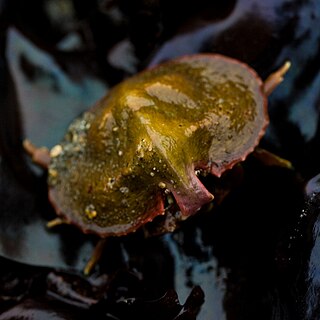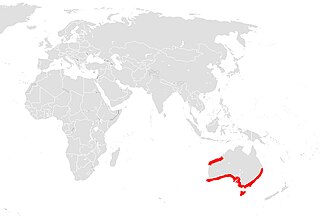 W
WThe Chinese mitten crab, also known as the Shanghai hairy crab, is a medium-sized burrowing crab that is named for its furry claws, which resemble mittens. It is native to rivers, estuaries and other coastal habitats of East Asia from Korea in the north to Fujian, China in the south. It has also been introduced to Europe and North America, where it is considered an invasive species.
 W
WChiromantes dehaani is a mudflat crab of the Sesarmidae family, which is endemic to East Asia. It typically lives in mangrove swamps and is known under the common name kurobenkeigani in Japan. C. dehaani has an uneven carapace, which is divided into four frontal lobes. Its walking legs are covered with thick, long setae (hairs), while the palm surfaces of its rough, granular chelipeds (claws) contain tubercules.
 W
WCryptolithodes sitchensis, variously known as the umbrella crab, Sitka crab or turtle crab, is a species of lithodid crustacean native to coastal regions of the northeastern Pacific Ocean, ranging from Sitka, Alaska to Point Loma, California. Its carapace extends over its legs such that when it pulls in its legs, it resembles a small stone. It lives in rocky areas from the low intertidal to depths of 17 m (56 ft).
 W
WCyclograpsus granulosus, the purple mottled shore crab or smooth shore crab, is an Australasian crab species.
 W
WThe smooth shore crab, Cyclograpsus lavauxi, is a marine large-eyed crab of the family Grapsidae, found in New Zealand and the Juan Fernández Islands of Chile.
 W
WGecarcinus quadratus, known as the red land crab, whitespot crab, Halloween crab, moon crab, Halloween moon crab, mouthless crab or harlequin land crab, is a colourful land crab from the family Gecarcinidae.
 W
WGnorimosphaeroma oregonense, the Oregon pill bug, is a small intertidal isopod crustacean. It is an oval-shaped organism roughly 6 mm in length, and about twice as long as it is wide. The primary habitat of G. oregonense is the mid-Californian to Alaskan coast, where it inhabits tidal pools and the intertidal region up to depths of 24 metres (79 ft).
 W
WHemigrapsus sanguineus, the Japanese shore crab or Asian shore crab, is a species of crab from East Asia. It has been introduced to several other shores, and is now an invasive species in North America and Europe.
 W
WHyperia macrocephala is a species of zooplankton, an amphipod in the family Hyperiidae.
 W
WIais pubescens is a species of marine isopod in the family Janiroidea. It inhabits seashores in a large number of locations in the southern hemisphere and may be found both free-living, and as commensals on larger isopods.
 W
WLigia australiensis, the Australian marine slater, is a woodlouse in the family Ligiidae.
 W
WLigia occidentalis is a species of rock slater in the family Ligiidae. It is found in North America and Mexico.
 W
WParhyale hawaiensis is an amphipod crustacean species that is used in developmental and genetic analyses. It is categorized as an emerging model organism as the main biological techniques necessary for the study of an organism have been established.
 W
WPercnon gibbesi is a species of crab. It is one of at least two species commonly called "Sally Lightfoot", and is also referred to as the nimble spray crab or urchin crab. It has been described as "the most invasive decapod species to enter the Mediterranean".
 W
WPorcellio monticola is a species of woodlouse in the genus Porcellio belonging to the family Porcellionidae that can be found in such European countries as Austria, France, Germany, Hungary, Luxembourg, Spain, and Switzerland.